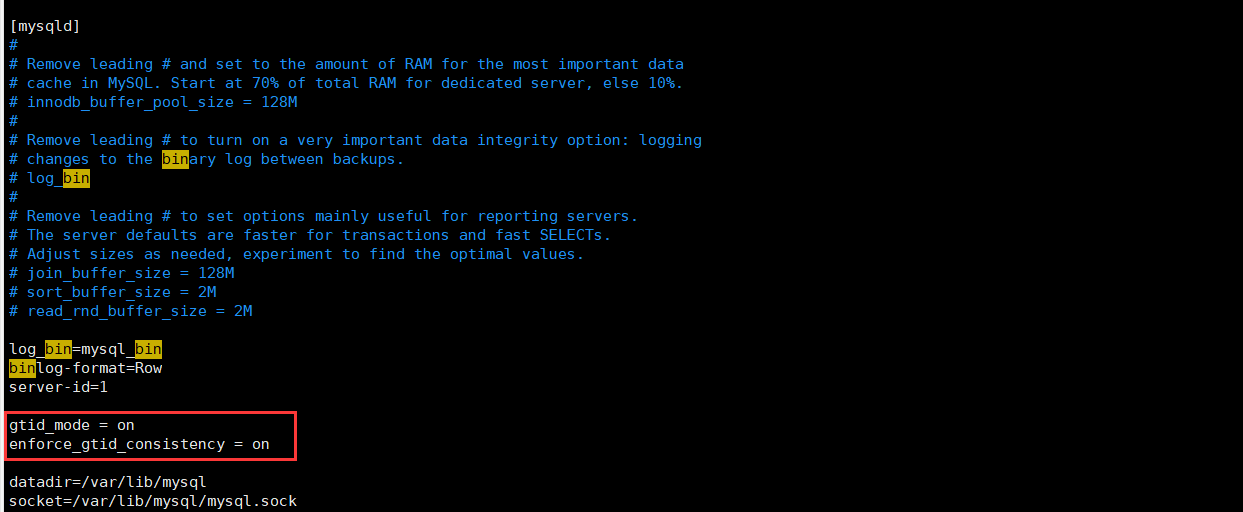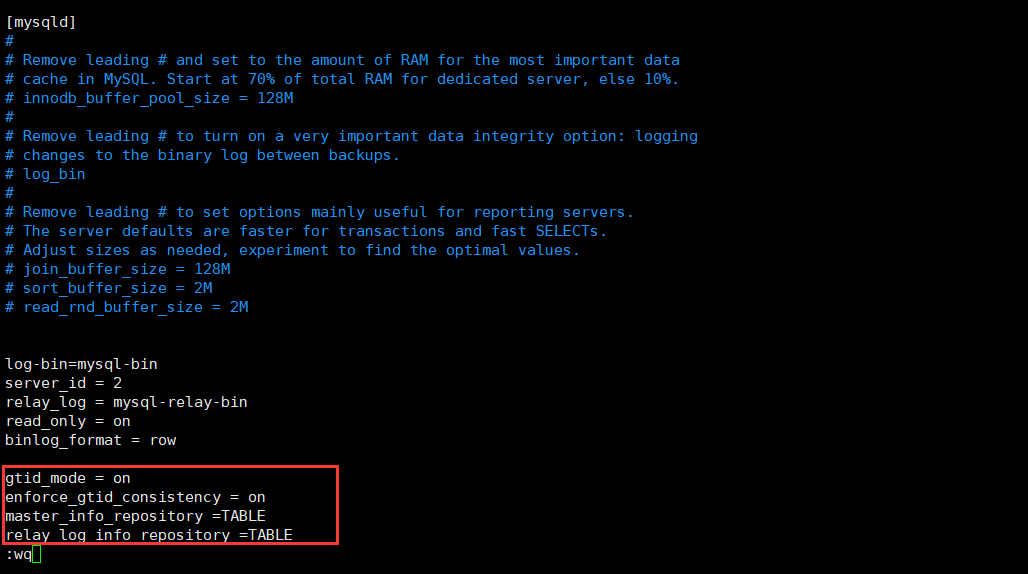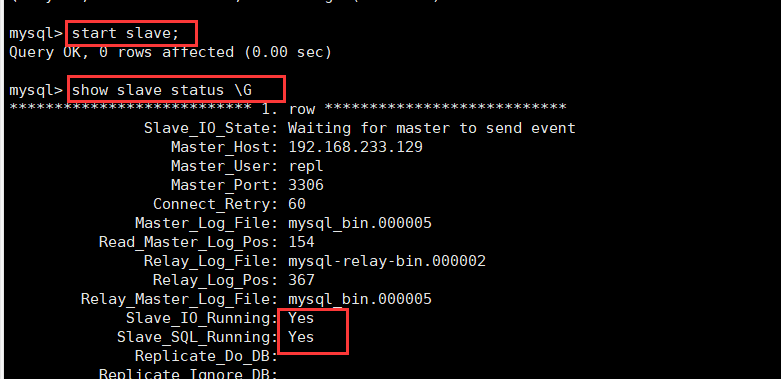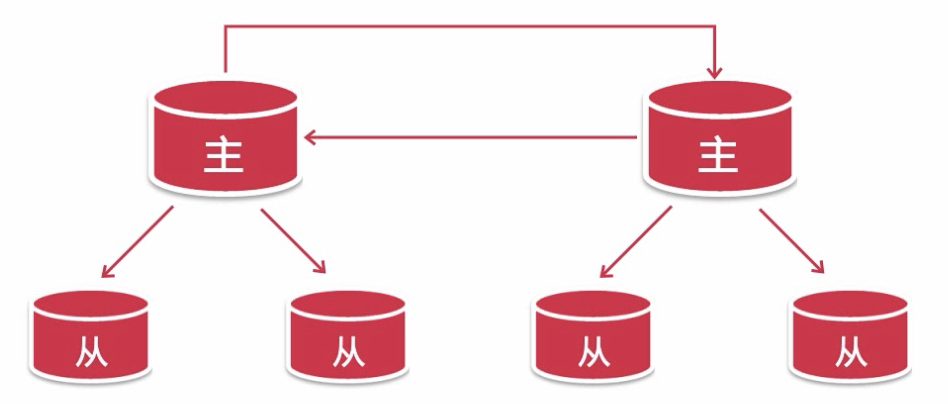What problems does mysql replication solve
- Realize data distribution on different servers
- Load balancing of data reading
- Enhanced data security
- Achieve high database availability and failover
- Realize online database upgrade
mysql binary log
Service layer log
- Binary log
- Slow check log
- General log
Storage engine tier log - innodb redo log
- innodb rollback log
Binary log
MySQL binary log is a binary file, which is mainly used to record MySQL statements that modify data or may cause data changes. The binary log records all operations that change the MySQL database and other additional information such as statement occurrence time, execution time, operation data, etc., but it does not record SQL statements that do not modify data such as SELECT and SHOW. Binary log is mainly used for database recovery, master-slave replication, and audit operations.
Format of binary log (segment)
Segment based format binlog_format=STATEMENT
- Advantages: the amount of log recording is relatively small, saving disk and network I/O
- Disadvantages: the data of the primary and standby servers replicated by MySQL may be inconsistent
Check whether it is on SHOW VARIABLES LIKE 'log_bin'; Can be in my.ini Adding a configuration to the file requires a reboot [mysqld] log_bin = mysql_bin #Log file name Modify to segment log set session binlog_format=statement;
Format of binary log (line)
Line based log format binlog_ format= ROW
, row format can avoid the inconsistency between master and slave in MySQL replication
mysql> show variables like 'binlog_format'; +---------------+-------+ | Variable_name | Value | +---------------+-------+ | binlog_format | ROW | +---------------+-------+ 1 row in set (0.02 sec)
same SQL Statement modifies 10000 pieces of data The segment based log format will only record this SQL sentence There will be 10000 records in the row based log, recording the data modification of each row separately The data in the database is modified due to misoperation,At the same time, there is no backup Recovery time,We can analyze binary logs,Record in log The data modification operation is reverse processed to achieve the purpose of restoring data
If binary log is enabled, you can view the contents of binary log records.
mysqlbinlog --vv mysql-bin.000003 | more
shortcoming
- The amount of logs is relatively large
Binary log format (mixed)
Mixed log format binlog_format= MIXED
characteristic
- According to the SQL statement, the system decides on segment based and row based
Select from the log format - The amount of data executed by the SQL statement determines the size
Influence of mysql binary log format on replication
SQL name based replication (SBR)
The binary log format uses the statement format
The SQL segment based log is the SQL that is re executed from the database
advantage
- The amount of logs generated is small, which saves network transfer I/O
- It is not mandatory that the table definitions of the master and slave databases are exactly the same
- It is more flexible than row based replication
shortcoming
- For non deterministic events, the consistency of master-slave replicated data cannot be guaranteed
- For stored procedures, contactors and custom functions, you can also modify them
Can cause data inconsistency - Compared with row based replication, more row locks are required when executing from
Row based replication (RBR)
The binary log format uses the line based log format
The row based log is to directly apply the changes to the database rows from the database
advantage
- It can be applied to any SQL replication, including non deterministic functions that have been stored
Cheng et al - You can reduce the use of database locks
shortcoming
- The table structure of the master-slave database is required to be the same, otherwise the replication may be interrupted
- It is impossible to execute the trigger on the slave server alone (row based replication is applied directly on the slave server, and the master database modifies the row instead of re executing sql on the slave server)
Mixed mode
Switch between the above two according to the actual content
How mysql replication works
- 1. The master writes the changes to the binary log
- 2. Read the binary log changes from the master and write them to the relay_log (log point based replication, GTID based replication)
- 3. Replay relay on_ Log in log
Log point based replication
Log point based replication configuration steps
Establish a replication account on the primary DB server
CREATE USER 'repl' @' IP paragraph' identified by 'PassWord'; GRANT REPLICATION SLAVE ON *.* TO 'repl' @ 'IP paragraph';
Configure primary database server
log_bin = mysql-bin server_id = 1
Configure slave database server
log_bin = mysql-bin server_id = 2 relay_log = mysql-relay-bin log_slave_update = on [Optional] read_only = on [Optional] relay_log: The default is the host name. If it is not specified, there will be problems in modifying the host name in the future log_slave_update: (Connected replication (if the slave server needs to be replicated as the master server, it needs to be configured) read_only: Avoid modifying the slave server data due to the configuration error of the slave server.
Initialize slave data
mysqldump backs up the main database. This method needs to lock the database. If the business traffic is very frequent, using this method will cause blocking. It will affect the concurrency of the database. Master data records the offset information of binary log files-- The single transaction hybrid storage engine needs to use other parameters.
xtrabackup is a database hot backup software. If the storage engines are innodb, the backup will not produce blocking. A hybrid storage engine will.
mysqldump --master-data=2 --single-transaction xtrabackup --slave-info
Start the replication connection and use it in the slave library
CHANGE MASTER TO MASTER_HOST= 'master_host_ip', MASTER_USER= 'repl' MASTER_PASSWORD= 'PassWord' MASTER_LOG_FILE= 'mysql_log_file_name', MASTER_LOG_POS=4;
Actual operation (MySQL 5.7 installed using yum)
Creating replication users and authorizations in the master library
create user repl@'192.168.233.%' identified by '123456'; grant replication slave on *.* to repl@' 192.168.233.%';
Modify my CNF configuration file, in the / etc / directory
[the external chain picture transfer fails. The source station may have anti-theft chain mechanism. It is recommended to save the picture and upload it directly (img-kaxeq6ue-1623547394676) (15a27aaeb9884646a5362f19e1e0560)]
Restart database
Before backing up the database, you need to lock the main database, and then back up. Otherwise, inserting data in the time period before the backup has been imported will cause the problem of data inconsistency.
# Lock flush tables with read lock; # Unlock unlock tables;
Back up the main database and use mysqldump
- If the version of the master-slave database is inconsistent, it is best to back up only the business database. If the system database is also backed up, there may be problems due to the inconsistent version.
mysqldump --single-transaction --master-data=2 --triggers --routines --all-databases -uroot -p >> /opt/all.sql;
- mysql5.6 when using mysqldump for backup, specify the specific database to be backed up, and use – database
- mysql5.7 when using mysqldump for backup, specify the specific database to be backed up, and use – databases
All. From server 129 Send SQL to 130
scp -r all.sql root@192.168.233.130:/opt/
Modify restart from server
[the external chain picture transfer fails. The source station may have anti-theft chain mechanism. It is recommended to save the picture and upload it directly (img-nIu2S58i-1623547394678)(9970044E4BC44AC3804B0E2243640C89)]
Import the slave library to make the master-slave data consistent.
[root@hadoop130 opt]# mysql -uroot -p<all.sql
Log in to MySQL, configure replication connectivity, MASTER_LOG_FILE='mysql_bin.000001', MASTER_LOG_POS=154, file and offset can be from all Check in the SQL file.
Or use the mysql command line to view
mysql> show master status; +------------------+----------+--------------+------------------+-------------------+ | File | Position | Binlog_Do_DB | Binlog_Ignore_DB | Executed_Gtid_Set | +------------------+----------+--------------+------------------+-------------------+ | mysql_bin.000001 | 154 | | | | +------------------+----------+--------------+------------------+-------------------+ 1 row in set (0.02 sec)
mysql> CHANGE MASTER TO MASTER_HOST= '192.168.233.129',
-> MASTER_USER= 'repl',
-> MASTER_PASSWORD= '123456',
-> MASTER_LOG_FILE='mysql_bin.000001', MASTER_LOG_POS=154;
Query OK, 0 rows affected, 2 warnings (0.01 sec)
start-up
mysql> start slave; mysql> show slave status \G
[the external chain picture transfer fails. The source station may have anti-theft chain mechanism. It is recommended to save the picture and upload it directly (img-wau27Ijj-1623547394679)(6BD592B857624192AD499AAD70AC2DFF)]
advantage
- It is the earliest replication technology supported by MySQL, and there are relatively few bugs
- There are no restrictions on SQL queries
- Fault handling is relatively easy
shortcoming
- It is difficult to retrieve the log point information of the new master during failover
GTID based replication
Since version 5.6
If the offset of log point based replication is wrong, duplicate replication or missing replication may occur, while the same transaction of GTID based replication is only executed once from the library.
GTID based configuration steps
GTID is the global transaction ID, which is guaranteed for each transaction submitted on the master database
A unique ID can be generated in the replication cluster
GTID=source_id:transaction_id
Configure primary database server
#GTID:
server_id = 1
gtid_mode = on
enforce_gtid_consistency = on
#binlog
log_bin = mysql-bin
log-slave-updates = on
binlog_format = row
sync-master-info = 1
sync_binlog = 1
enforce-gtid-consiste(force gtid uniformity)
Impact: 1.out of commission create table ... select Such a statement
2.Use in transactions Create temporar table Creating a temporary table and updating the transaction table and non transaction table with association will report an error
log-slave-updates = on(Record the modification log from the master server from the slave server)
be careful: mysql>=5.7 You don't need this parameter.
reference resources: https://blog.51cto.com/hcymysql/1579197
Configure slave database server
#GTID: server_id = 2 gtid_mode = on enforce_gtid_consistency = on #binlog log_bin = mysql-bin log-slave-updates = on binlog_format = row sync-master-info = 1 sync_binlog = 1 #relay log skip_slave_start = 1 read_only = on[proposal] master_info_repository =TABLE [proposal] relay_log_info_repository =TABLE [proposal] The latter two configurations specify the information of connecting from the server to the master server and the storage method of the intermediate log. By default, it is stored in the file. Through the above configuration, the information can be stored in the table of the database. In case of database crash, it can be saved through the innodb Restore the characteristics of the transaction to ensure that the slave server can replicate in the correct location. skip_slave_start = 1 [proposal] reference resources: https://www.cnblogs.com/liang545621/p/9400031.html
Create a copy account
Initialize the slave server database to keep the master-slave consistency
Start GTID based replication
CHANGE MASTER TO MASTER_HOST= 'master_host_ip' , MASTER_USER= 'repl', MASTER_PASSWORD= 'PassWord', MASTER_AUTO_POSITION = 1;
Case operation
1. Create a user for replication in the main database of 129, which has been created above.
2. Add two parameters to the main library compared with the previous one

Restart mysql

3. Add parameters from library

4. Initialize the data and restore the data from 129 server to 130 server
mysqldump --single-transaction --master-data=2 --triggers --routines --all-databases -uroot -p >> /opt/all_gtid.sql;
Send the sql file to 130
scp -r all_gtid.sql root@192.168.233.130:/opt/
Import the slave library to make the master-slave data consistent.
[root@hadoop130 opt]# mysql -uroot -p123456<all_gtid.sql
5. Configure master-slave on the slave Library of 130, which needs to be closed first
mysql> stop slave;
Query OK, 0 rows affected (0.01 sec)
mysql> CHANGE MASTER TO MASTER_HOST= '192.168.233.129',
-> MASTER_USER= 'repl',
-> MASTER_PASSWORD= '123456',
-> MASTER_AUTO_POSITION=1;
Query OK, 0 rows affected, 2 warnings (0.01 sec)

advantage
- It is convenient to perform failover (globally unique transaction id)
- The slave library will not lose any changes on the master library
shortcoming
- Fault handling is complicated
- There are certain restrictions on the SQL executed
Issues to consider when selecting replication mode
- MySQL version used
- Replication architecture and master-slave switching mode
- High availability management components used
- Support for applications
Replication architecture
MySQL5. Before 7, a slave library could only have one master library
MySQL5. After 7, it supports one slave multi master architecture
One master multi slave architecture
advantage
- Simple configuration
- Multiple slave libraries can be used to share the read load
purpose
- Use different slave libraries for different businesses
- Put one from the library to the remote IDC for disaster recovery
- Share the read load of the main library
Primary primary replication topology with standby database

Handling of common problems in Mysql replication
Master slave replication error caused by data corruption or loss
- Error caused by unexpected downtime of primary or secondary Library
Skip binary log events using Inject empty transactions to restore the interrupted replication link first Then use other methods to compare the data on the master-slave server
-
The binary log on the primary library is corrupted
-
The relay log on the standby database is damaged
-
Master slave replication error caused by data modification on slave Library
-
Not a unique server_id or server_uuid
server_uuid Is recorded in the data directory auto.cnf In the file
- max_ allow_ Master slave copy error caused by packet setting